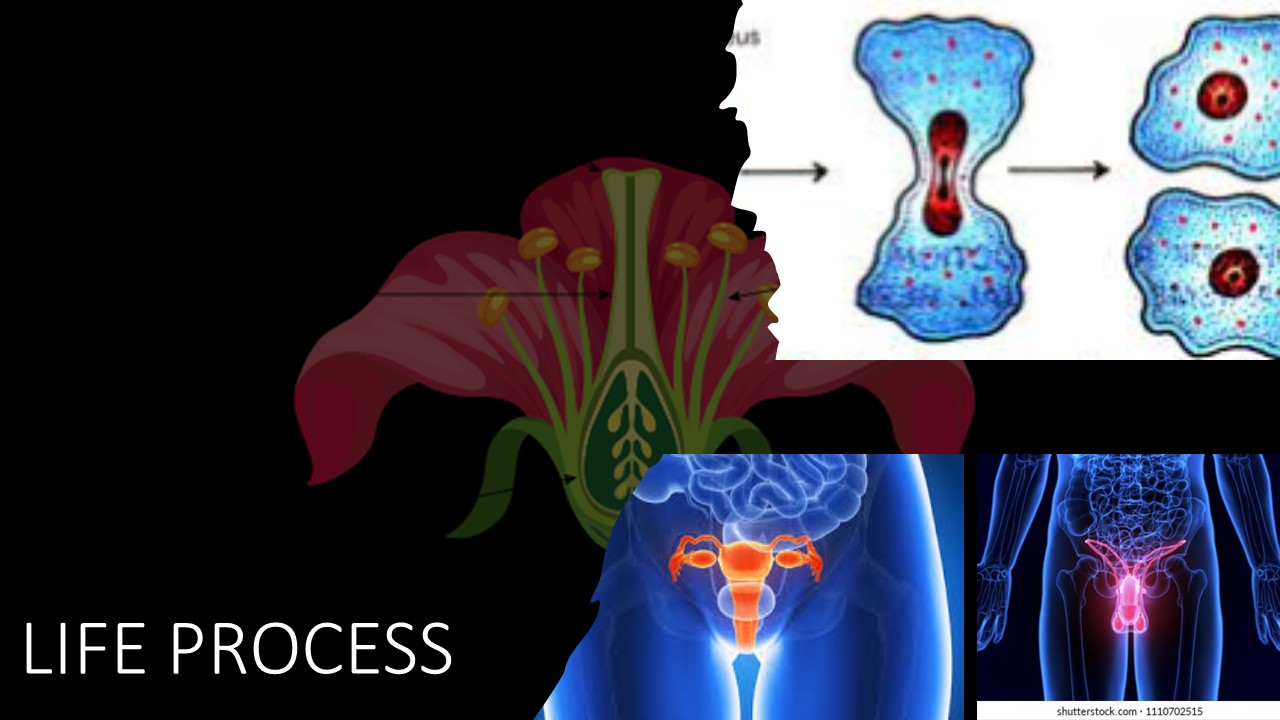STD VIII – LIFE PROCESS – REPRODUCTION IN PLANTS AND ANIMALS (Hybrid)
About Course
In this section will learn this following chapters:
1.TYPES OF ASEXUAL REPRODUCTION
2.SEXUAL REPRODUCTION
3.ANIMALS
Last Updated:December 21, 2024
0 (0 Ratings)
Share Course
Page Link
Share on social media

Description
Asexual and Sexual Reproduction in Plants
Reproduction in plants is either asexual or sexual.
Sexual reproduction produces offspring that are not identical to their parents, whereas asexual reproduction produces identical offspring. Two parents are needed in sexual reproduction, and the offspring produced are genetically different to the parents.
Only one parent is needed in asexual reproduction, and the offspring produced are genetically identical.
Pollination
It is of 2 types: self-pollination and cross-pollination
Self-pollination: The pollen falls on the stigma of the same flower. It can occur only in bisexual flowers.
Cross-pollination: The pollen falls on the stigma of a flower on another plant of the same kind.
Fertilization in Plants
1.The ovule with the fertilised cell develops into a seed. The ovary turns into the fruit while the ovule covering becomes the seed coat. The other parts of the flower now drop off.
2. A ripened ovary is called a fruit
Reproduction in Animals
All organisms need to reproduce otherwise, there will be no more of that species.
Reproduction is the process by which an organism gives birth to a new individual. In other words, reproduction is to create or recreate a new living thing, such as a baby.
Reproductive phase is the phase in the life of every individual which makes the individual capable of reproducing the offspring.
Animals reproduce in one of two ways:
Asexual reproduction: Asexual reproduction only involves a single organism. In this animals produce young, which are identical to themselves, without mating with another animal. It works by division (or splitting) of the cell. Most creatures that reproduce in this way do not live very long but can reproduce in large numbers rapidly. Most bacteria reproduce by this method.
Sexual reproduction: Sexual reproduction involves two organisms of the same species, each supplying half the genes for the descendant. Here a female animal’s egg unites with a male’s sperm cell after mating, in a process known as fertilization. The offspring inherit features, called traits, from both parents. These animals tend to develop more slowly and many have parental care after birth.
Free
Free
Free access this course
-
LevelIntermediate
-
Total Enrolled4
-
Last UpdatedDecember 21, 2024
Hi, Welcome back!
Material Includes
- 🔥 Live Interactive classes with in-class doubt solving
- ⭐ Weekly Test and Quiz with instant tracking for progress
- ⚙️ Revision of the course after testing
- 👋 Fortnightly Parents and Tutor interactions
- 🌷 Expert monitoring of student's learning progress
- 👨👩👧👧 Daily communication over call, whatsapp and mail
- 💻3 hours on-demand video
- ✍4 downloadable resources
- ⌛Access for entire Academic Year
- 📱Access on mobile and Desktop
- 📋Assignments and review of the same
- 💡Tests and Correction by Board paper checkers
- 🏅Certificate of completion and Live tracking with Grade book
Course Duration:
0
Course level:Intermediate
Enrolled:4
About Course
In this section will learn this following chapters:
1.TYPES OF ASEXUAL REPRODUCTION
2.SEXUAL REPRODUCTION
3.ANIMALS
Course Curriculum
SEXUAL REPRODUCTION IN PLANTS
-
SEXUAL REPRODUCTION IN PLANTS – CORE CONCEPT – STRUCTURE OF A FLOWER
12:47 -
SEXUAL REPRODUCTION IN PLANTS – FLOWER – SUPPORT MATERIAL – STRUCTURE OF A FLOWER
01:38 -
SEXUAL REPRODUCTION IN PLANTS – CORE CONCEPT – ESSENTIAL PARTS AND NON ESSENTIAL PARTS OF A FLOWER
13:14 -
SEXUAL REPRODUCTION IN PLANTS – SUPPORT MATERIAL – POLLINATION
01:11 -
SEXUAL REPRODUCTION IN PLANTS – SUPPORT MATERIAL REPRODUCTION IN PLANTS
09:00 -
SEXUAL REPRODUCTION IN PLANTS – SUPPORT MATERIAL – FERTILIZATION
00:25 -
REPRODUCTION IN PLANTS – PHYSICAL CLASS – ASEXUAL REPRODUCTION
18:44 -
REPRODUCTION IN PLANTS – PHYSICAL CLASS – REPRODUCTION BY VEGETATIVE REPRODUCTION
09:05 -
REPRODUCTION – PHYSICAL CLASS – REPRODUCTION IN PLANTS – VEGETATIVE COMPONENT
14:56 -
REPRODUCTION – PHYSICAL CLASS – REPRODUCTION IN PLANTS
20:39 -
REPRODUCTION – PHYSICAL CLASS – SEXUAL REPRODUCTION IN PLANTS – BISEXUAL FLOWER
06:56 -
REPRODUCTION IN PLANTS – PHYSICAL CLASS – CONTINUE
19:51 -
REPRODUCTION IN PLANTS – PHYSICAL CLASS – INTRODUCTION
23:08 -
REPRODUCTION IN PLANTS – PHYSICAL CLASS – PART -I
23:23 -
REPRODUCTION IN PLANTS – PHYSICAL CLASS – PART -II
23:23 -
QUIZ – THE FLOWER > GENERAL DESCRIPTION OF THE FLORAL PARTS
-
QUIZ – THE FLOWER > STRUCTURE OF A BISEXUAL FLOWER
SEXUAL REPRODUCTION IN ANIMALS
-
SEXUAL REPRODUCTION IN ANIMALS – SUPPORT MATERIAL – INTRODUCTION TO REPRODUCTION IN ANIMALS
00:54 -
SEXUAL REPRODUCTION IN ANIMALS – SUPPORT MATERIAL – MALE AND FEMALE REPRODUCTIVE ORGANS
00:54 -
SEXUAL REPRODUCTION IN ANIMALS – SUPPORT MATERIAL – STRUCTURE AND FUNCTION OF EGGS AND SPERM
00:54 -
SEXUAL REPRODUCTION IN ANIMALS – SUPPORT MATERIAL – REPRODUCTION IN ANIMALS
07:07 -
REPRODUCTION IN ANIMALS – PHYSICAL CLASS – BIRTH
02:31 -
REPRODUCTION IN ANIMALS – PHYSICAL CLASS – SEXUAL AND ASEXUAL REPRODUCTION
18:52 -
REPRODUCTION IN ANIMALS – PHYSICAL CLASS – SEXUAL REPRODUCTION IN MAMMALS
18:00 -
REPRODUCTION IN HUMAN – PHYSICAL CLASS – PART – I
19:08 -
REPRODUCTION IN HUMAN – PHYSICAL CLASS – REVISION
03:15 -
QUIZ – THE REPRODUCTIVE SYSTEM > REPRODUCTION IN GENERA
-
QUIZ – THE REPRODUCTIVE SYSTEM > FERTILIZATION ( UNION OF EGG AND SPERM )
Student Ratings & Reviews

No Review Yet

